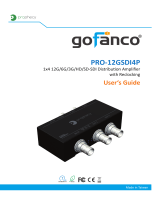
GS12141
User Guide Rev.1
PDS-061032 December 2015
4 of 15
Semtech
Proprietary & Confidential
www.semtech.com
1.1 GS12141 Receiver IBIS Model
The GS12141 Receiver IBIS model consists of three parts: (1) the Analog Termination IBIS
model, (2) the Receiver AMI model, and (3) the QFN package model. The block diagram
in Figure 1-2 shows the sequence of signal flow and the individual parts of the model.
The external S-parameter file for the QFN Package model extends the accuracy of the
package effects beyond what can be described by R, L and C components in the IBIS 5.0
standard. The external S-parameter data is processed as part of the channel by the EDA
platforms.
Figure 1-2: GS12141 Receiver IBIS Model
1.1.1 GS12141 Receiver IBIS Model
The GS12141 receiver IBIS model is extracted from device simulation results. The
receiver IBIS model contains the GS12141 Receiver input termination circuitry and is
used by the EDA platform to determine the time-domain impulse response for the
channel. The current revision of the IBIS model contains typical (Typ), maximum (Max),
and minimum (Min) corners which can be selected from the EDA user interface.
Note that the IBIS model only contains the DC termination impedance of the receiver.
Frequency dependent simulation (e.g. return loss) using the IBIS file is not accurate. It is
recommended to use GS12141_RX_Term.s2p S-parameter file instead of the IBIS file for
input return loss (IRL) simulations. See Section 1.1.5 for details on the return loss
simulation setup.
1.1.2 GS12141 Receiver AMI Model
The GS12141 Receiver AMI model includes an equalizer and slicers. Note that the
receiver AMI model is designed for the 12G and 6G data rates (11.88Gb/s and 5.94Gb/s
respectively) and should not be used for lower data rates. For simulation at 3G and lower
rates, IBIS-only simulation without the AMI model should be used. The AMI model does
not include automatic equalization. The equalization level is controlled by the
cable_length model specific parameter, which specifies the cable length (in meters) for
signal restoration.
The upstream transmitter launch swing is specified via the launch_swing model specific
parameter. Table 1-1 shows the value of the launch_swing parameter for different
launch swings.
Input
IBIS
Model
Package
Model
(S-parameters)
Algorithmic
Model
From Channel
Receiver IBIS-AMI Model


























